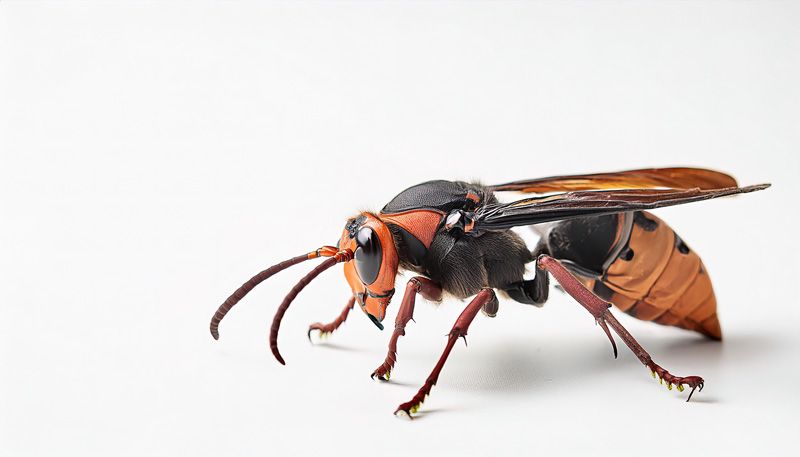
Northern Giant Hornet – Asian Giant Hornet – Vespa mandarinia
Northern Giant Hornet – Asian Giant Hornet – Vespa mandarinia
Description of Insect:
The northern giant hornet (Vespa mandarinia), also known as the Asian giant hornet, is the world’s largest hornet species. Native to East Asia, this formidable insect has gained popularity for its size and devastating impact on honeybee colonies.
They have an orange-yellow head, dark brown to black eyes, a dark brown thorax, and a distinctive yellow-and-black striped abdomen. Adult hornets measure approximately 45 mm in length, with a wingspan of 75 mm. Their powerful orange mandibles with a black tooth and long stingers, measuring 6 mm make them highly effective predators. The larvae are creamy-white with a yellow head and segmented bodies, growing up to 38 mm.
Northern giant hornets exhibit social behavior, forming colonies that can contain several hundred individuals. Their nests are typically subterranean, often located in abandoned rodent burrows or hollow tree trunks. Their most infamous behavior is their predation on large insects, such as honeybees, other hornets, beetles, and wasps. A single hornet can kill as many as 40 bees per minute, wiping out entire colonies in a few hours. This gives them the nickname, “murder hornet.”
Life cycle of Northern Giant Hornet
The life cycle of the northern giant hornet follows a pattern similar to other social wasps. Their life cycle progresses through four stages: egg, larva, pupa, and adult. Each year, a new colony begins when a mated queen emerges from hibernation in early spring. She seeks out a suitable nesting site, where she lays her first batch of almost 40 eggs.
These eggs hatch into larvae that she feeds with chewed-up insects. Over the next few weeks, the larvae pupate and develop into worker hornets, which then take over the foraging and nest-building duties. It takes approximately 40 days for the workers to grow from eggs to adults.
As summer progresses, the colony expands rapidly, with workers hunting insects and honeybees to feed the developing brood. By the end of summer, reproductive individuals—new queens and drones (males) are produced. Mating occurs in fall, after which the fertilized queens leave the nest to find overwintering sites. The old colony, including the original queen, dies off with the onset of winter. On the other hand, the new queens remain dormant until the following spring, continuing the cycle.
Damage they cause:
Northern giant hornets are considered a serious ecological and economic threat due to their predation on pollinators and disruption of ecosystems.
- Ecological Impact: One of the most concerning effects of northern giant hornets is their impact on biodiversity. Western honeybees, which are commonly kept by beekeepers in North America, are highly vulnerable to hornet attacks. The loss of honeybees can have cascading effects on pollination, impacting fruit and vegetable crops that rely on these pollinators.
- Health Hazard: Beyond agriculture, northern giant hornets pose a public nuisance and health hazard to humans. Their powerful sting and toxic venom make them a threat to outdoor workers, hikers, and residents in infested areas. In Japan, where the hornet is native, 30 to 50 people die each year due to allergic reactions. The venom causes anaphylactic reactions, sudden cardiac deaths, and other rare complications like kidney failure, and liver dysfunction.
